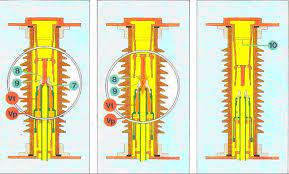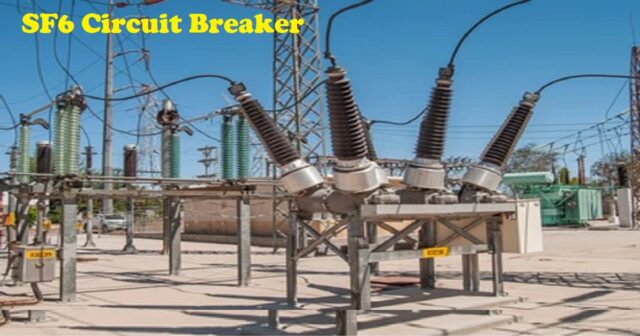What is an SF6 Circuit Breaker?
One form of circuit breaker (CB) that uses pressurised SF6 gas to quench the arc is the SF6 circuit breaker, also known as sulphur hexafluoride. A dielectric gas with arc quenching and high insulating qualities is SF6. It is mostly utilised in electrical grids and power plants up to 800 kV to quench the arc in high voltage CBs. A gas that is electro-negative and has a significant propensity to absorb free electrons is SF6.
The SF6 (Sulphur Hexafluoride) circuit breaker is used in electrical equipment with high voltages. These are commonly found in electric power transmission, substations, and other similar facilities where high-voltage circuits are connected to buildings, motors, transformers, switches, etc.
This article will cover all the information about sf6 circuit breakers like their different types, construction, working of sf6 circuit breakers, and their application in different industries.
Uses of SF6 circuit breaker

In the SF6 circle breaker, pressurized sf6 gas is used to open the arc. Since the nature of the gas is dielectric. Since the nature of this SF6 gas is dielectric therefore it serves as a medium for quenching arcs. SF6 circuit breakers are very useful when high power and high voltage appliances are used.
They are used to protect high voltage circuits up to 800kV from the occurrence of fault voltage current. They are also used in distribution systems for up to 35kV voltages as an insulating and current-breaking medium. They are also used because of their non-flammable property.
Properties of SF6 gas used in circuit breakers
SF6 circuit breaker exhibits the following properties of the gas.
- The SF6 gas used in the circuit breaker is highly non-inflammable.
- It is a colorless and odorless gas.
- SF6 circuit breakers have excellent thermal conductivity.
- They have a very great dielectric strength dependent on pressure.
- They are also made up of non-corrosive materials.
- SF6 gas is a non-toxic and inert gas.
- SF6 gas is also non-hazardous.
- SF6 gas is chemically stable in STP conditions.
Types of SF6 circuit breaker
The following three types of circuit breakers are available in the market
- Non-puffer type
- Single Pressure puffer type
- Double pressure puffer type
Non-puffer type
The first and oldest available SF6 circuit breaker is a non-puffer type, as they do not contain a puffer cylinder. The sf6 circuit breakers have two contacts, fixed and movable; both are hollow cylinder shapes. While the movable contact oscillates back and forth, the fixed contact is immovable.
Both contacts begin to separate from one another in the event that the system experiences an electrical malfunction. The medium available in the contact gets ionized, and an arc is a product between the contacts.
Single Pressure puffer type
Single pressure is another feature of this kind of SF6 circuit breaker. A hollow cylinder that serves as a bridge between contacts is known as a puffer cylinder. It glides upward and downward to make and break contact between the two fixed spots.
A puffer cylinder is positioned on top of the little space between the two fixed terminals. There is SF6 gas within the cylinder. In the cylinder, there is a stationary point. The cylinder’s volume changes as it moves because of the constant position. Additionally, the cylinder has vents that prevent the upper fixed contact from working.
Double pressure puffer type
This double-pressure SF6 circuit breaker used compressed gas to quince the arc. Such CBs are older and not used now. These types of SF6 circuit breakers have a fixed and moveable contact. When in the closed position, the fixed contact is designed to stop SF6 gas from flowing.
The only difference between it and an air blast circuit breaker is that the gas is compressed, recombined, and then stored in the gas cylinder, making it incredibly expensive and complex since it needs a gas system to run. The release SF6 circuit breaker is stored in the cylinder for further utilization. The gas escapes because the pressure inside the cylinder is higher than the pressure outside. A heating system prevents the gas from melting as a result.
This circuit breaker technology is not used anymore.
Interested to know details about ‘Nest Thermostat’, read this article: What Is Nest Thermostat? How To Troubleshoot Nest Thermostat? in our ‘Tech’ category.
Pros and cons of SF6 circuit breakers
Pros:
- Circuit breakers made of SF6 have far better arc quenching capabilities than those made of air.
- The arching time is concise.
- These types of circuit breakers have high dielectric strength and high electronegativity.
- Due to its tiny form, it is small and simple to install.
- SF6 gas can handle different stitching scenarios.
- SF6 circuit breakers are non-inflammable and hence have no chance of getting fired.
- Circuit breakers made with SF6 gas require minimal service.
- Its closed gas circuit prevents sound during operational bursts.
- These SF6 circuit breakers are also designed to protect them from moisture due to the compact construction of their system.
- Its operation is almost soundless because of its construction.
Cons:
- The production of by-product gasses formed by SF6 gas during aching is hazardous to the environment.
- SF6 is expensive gas, so the circuit breakers are costly.
- Since SF6 gas is heavier than oxygen, it may make breathing harder.
- One must ensure to properly monitor the leakage of the SF6 circuit breaker due to its structural imperfections.
- Recombination and reconditioning demand extra tools.
- Due to the high cost of SF6 gas, their breakers are very expensive.
- The SF6 gas decomposed, causing toxicity.
- Their installation and repair are also costly.
- Special transportation is required to preserve gas quality.
Application of SF6 circuit breakers:
The SF6 circuit breakers are used in the following applications;
- A high voltage-based circuit can be broken and depowered for maintenance or inspection.
- Their application is also utilized in power distribution and control.
- They protect the lines in power circuits.
- They protect transformers by acting as a barrier.
- SF6 circuit breakers are also used in rectifiers and capacitor circuits.
Conclusion
SF6 circuit breakers are effective electronic equipment for high voltage and high power and high voltage electrical systems. It is preferred to select the appropriate type of SF6 circuit breaker or consult a certified electrical technician for
the available type of circuit to be used. This article is a guideline that provides an insight into the types, pros and cons, different applications, and properties of SF6 circuit breakers.
Frequently Asked Questions (FAQs)
Apart from this, if you are interested to know more about Power Factor Controller then visit our TECH category.












